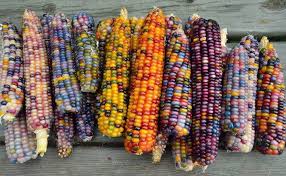Did you notice that some of the corn you bought from the market was yellow and some were like a big face with purple and white corn kernels in the middle?
In fact, this is the nature of corn. There are a lot of very active transposons in maize genes, they are like a "small brush", jumping to a certain gene, and will erase the original "color" there. Therefore, a part of the color change of grain was caused by the transposon movement.
Transposons change not only maize kernel color, but also almost all traits such as plant height, resistance, and yield. This unique genetic attribute has attracted the interest of scientists. For breeding needs, we should not only suppress the phenotypic instability caused by transposon skipping but also use the skipping of transposons to breed elite varieties.
Recently, the team of Zhao Han, a researcher at the Institute of Germplasm Resources of Jiangsu Academy of Agricultural Sciences in China, and Professor Song Rentao of China Agricultural University, and Shanghai University have collaborated for 7 years to create the world's largest maize transposon insertion repository and provide important genetic resources for global maize genome research. The relevant research report has been published recently in Plant Physiology.

The Perplexity of Maize Seed Color Change
In daily life, we can often see some colorful corn. In the eyes of ordinary people, this is not a big deal, because there is no difference in taste.
But half a century ago, American scientist Barbara McClintock was confused. Through persistent research, she eventually discovered a "jumping gene," or transposon. She also won the Nobel Prize for her pioneering research on transposons.
A transposon is a mobile piece of DNA on a chromosome that can jump from one location to another. Transposons are widespread in living organisms, but maize has the most transposons, accounting for more than 50% of DNA molecules. These transposition-capable genetic elements can trigger genome rearrangements and increase genetic diversity in maize varieties. According to Zhou Ling, an associate researcher at the Institute of Germplasm Resources and Biotechnology of the Jiangsu Academy of Agricultural Sciences, when a transposon jumps to a site within or adjacent to a functional gene, it can cause the loss of function controlled by the gene.
Because the hopping of transposons determines maize traits, researchers hope to obtain more optimized varieties by controlling the hopping of transposons.
In 1978, scientists discovered a new transposon system, the Mu transposon family. This is by far the most transpositional active as well as the most mutagenic transposable element found in plants. Generally, the traits affected by transposon skipping are not obvious, but when Mu transposon skips to a certain gene, it can cause the loss of gene function, resulting in a large number of mutant phenotypes and the formation of significantly altered traits.
In the study of gene function, mutants are the most direct and effective material. The creation of Mu transposon insertion mutant library provides abundant genetic resources for maize researchers. Therefore, foreign scholars began to cross with other maize inbred lines with Mu transposon donor material many years ago to select mutant individuals from insertional mutagenesis populations and form insertional mutant libraries.
The Mutant Bank has been opened to maize researchers worldwide
The construction of a large gene mutant library has become one of the important methods to create maize germplasm, obtain mutant genes, isolate and clone important functional genes, and then carry out functional genomics research. It can be said that who has a large pool of gene mutants can be at the forefront of related research.
“In the past, when domestic scholars studied a certain maize character, they needed to apply for mutant resources from the Uniform Mu insertion database constructed in USA. The cumbersome application procedures and unguaranteed quality are not conducive to the research and development in relevant fields in China." Zhou Ling said.
Since 2012, Jiangsu Academy of Agricultural Sciences and China Agricultural University have been working together to construct a mutant library of Mu mutants. The principle of mutant library construction is to use the Mu active line and the control sample, the B73 inbred line, to cross and use transposon tag isolation technology combined with the second generation of high-throughput sequencing technology to map the Mu transposon in the material, so as to form a large number of mutant material." Zhou Ling told the reporters.
Through years of hybrid planting, they sequenced more than 20,000 samples one by one, screened out 2581 plants of maize with significant genetic traits, and included them in the gene mutant library.
After seven years of effort, the current mutant gene pool has been fruitful. They obtained about 97,000 heritable insertion sites in 2,581 mutant accessions by Mu tag enrichment and high-throughput sequencing technology, combined with bioinformatic analysis, and large scale validation of the heritability of insertion sites, which is twice that of UniformMu, a US insertion database. Of these, 66,565 loci were high-quality heritable insertions, and the insertions covered 20,244 (45.7%) genes in maize, of which 13,425 genes had two or more insertions. Compared with the homogeneous gene pool in the United States, the coverage is wider and more traits are available for study, which has a profound impact on future maize germplasm optimization.
"Our gene mutant library is still being complemented with the ultimate goal of generating more than 4,000 mutant accessions with more heritable insertion sites." According to Zhou Ling, the insertion site of this mutant library has been open to global maize researchers to share.